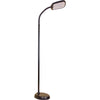
How to Choose Living Room Lighting
Search
Main Article: How to Choose the Right Light Fixtures for Your Room
The Purpose of a Living Room
A living room is a larger room where people live much of their lives when away from the kitchen, bathroom and bedroom. A living room is designed to be a gathering place, a place to rest and relax and enjoy entertainment, greet guests and meet with family.
The Lighting you'll need in a Living Room
The living room features comfortable seating areas, couches/sofas, perhaps a fireplace and a television. There may be small side tables, perhaps a coffee table and cozy chairs for reading and relaxing. Adapting your lighting choices to how people will use the room is important.
- Overhead ceiling lights are important for lighting up a larger room. Leave enough headroom in the areas where people will be walking, so that they can walk underneath the light fixtures.
- Chandeliers and pendants can be mounted as ceiling lights, provided you have enough headroom. You'll need either higher ceilings or place the fixtures over furniture.
- Semi-flush or flush-mounted lights also work well close to the ceiling and also leave plenty of headroom for walking underneath.
- Recessed "pot" lights can be used for a very minimalist look, recessed into the ceiling. They take up no room height and shine downwards, but you'll need several to light a living room.
- Wall sconces can be added at the sides of the room, especially near doors or behind seating areas, to add extra ambience. They complement the main light fixtures or could be used independently for a softer mood.
- Portable lamps such as table lamps, floor lamps and reading lamps place light at an ideal height for sitting, reading and relaxing. Ideal next to or behind seating areas, they can be switched on and off independently from the main lighting.
- Use a desk lamp if you have a desk area, and consider buffet lamps if you have a narrow side table or buffet.
- Add a ceiling fan to help with ventilation, heating and cooling. They can be placed over a seating area or in the center of the room and can double as a light fixture. Just make sure there is enough headroom for walking underneath if needed.
- Accent lighting can be added. For example spot lights can shine focused light in a specific direction, to e.g. light up a piece of wall art or furniture. Accent lamps can add decorative touches of gentle light. And can lights can give an interesting upward-pointing light, mounted on the floor.

The use of Lighting in your Living Room
The main function of your lighting should be to help people to see in the dark, especially in the evening and at night. You can add background lights, decorative lights and mood lighting but make sure you have a way to brightly light the room when needed.
Also consider where in the room people will spend the most time and what they will be doing there. Will they be sitting in certain areas? Performing tasks? Moving around? Needing to read or write or work in detail? Will they be focusing on things close to themselves or at a distance?
- Ambient Lighting is when the light is bright and spreads out in generally all directions, lighting up most of the room. Ambient light can also be background light. It is less focused and more diffused. Ceiling lights and wall lights can create ambient lighting.
- Task Lighting is when the light is more focused into a smaller area, possibly aimed in its direction, and is used when performing tasks. Such as when reading a book or working on crafts, you'll need light fixtures or lamps nearby so that you can see what you're doing.
- Accent Lighting comes from small accents of light generally in the background. This are the finishing touches such as small novelty lamps, can lights, spot lights, accent lamps and other decorative lighting. The amount of light output is usually less and limited to a smaller area.

Where to put Lighting in a Living Room
Main Light Fixtures
In a living room you'll likely want one or two main light fixtures, positioned fairly centrally in the room. These could be chandeliers, pendant lights, semi-flush mount lights, flush-mount lighting, or ceiling fans with lights.
If the room is longer than square, consider breaking it up into sections like separate rectangles, with one light in the center of each. Centrally positioned lights will emit light in all directions and light up most of the room.
Secondary Light Fixtures
To complement the main light fixture and provide additional layers and levels of light, adding a couple of wall sconces on a wall near to seating can be useful.
Also consider floor lamps or torchieres, which usually give off brighter light than other types of lamps. These can be positioned in corners or ends of the room, or next to seating areas to light up dark spots.
Task Light Fixtures
Often in a living room you'll see table lamps, which work well positioned at the sides of a couch on chairside/end-tables. When a person sits next to them they can benefit from the local light to help with tasks such as reading. An alternative is a reading lamp, which is a type of floor lamp designed to help with reading.
If you have other small areas which occasionally need bright light, such as a desk, consider a desk lamp or a floor lamp nearby. Table lamps also work well at the sides of a room as more of a background light for a casual mood with less brightness.
Consider eyesight and glare
When placing lighting in a living room, remember that light comes from a light bulb in most cases. The light may or may not be covered in all directions. For example, sitting below an overhead pendant light with a bulb that shines downward, if the pendant is high up near the ceiling it may shine into people's eyes who are sitting nearby.
Think about what direction the light will shine and what the line of sight will be. You might benefit from an overhead light when needed, but you may not want it shining in your face when watching television.

How much Lighting does your Living Room need?
The amount of light needed in a living room is usually at a medium level compared to other rooms. Also the size of the room and the natural lighting coming in through windows will affect the amount of light needed.
Light is best measured in lumens, which is a measure of how much light reaches a surface at a given distance. In general it means "brightness" in a standardized way. You'll need to calculate an idea of how much light you want in the room, and then try to aim to achieve this across your light fixtures and lamps.
A general approach is as follows:
- Measure the length and width of the room in feet..
- Multiply the two numbers to get the "square feet".
- Multiply the square feet by the amount of lumens needed per square foot for the room - for a living room this is 10-20 lumens per square foot.
For example in an 18 x 12 foot living room:
- 18 x 12 = 216 square feet.
- 216 x 10 = 2160 total lumens on the low end.
- 216 x 20 = 4320 lumens on the high end.
In terms of light bulbs: A single 60-watt incandescent light bulb outputs about 800 lumens. If you were using purely 60-watt bulbs, you'd need at least e.g. 2160 / 800 = 2.7 light bulbs minimally, up to 4320 / 800 = 5.4 bulbs maximally. So roughly 3 to 6 light bulbs at 60 watts each would be needed for a living room.

Recommended Lighting for a Living Room
Here are our top picks for types of lighting and light fixtures that would work best in a living room.
Ceiling Lights
Wall Lights
Lamps

More Rooms to Explore
Shop for Living Room Lighting
We've curated our light fixtures to save you time.
Shop now by showing only living room lighting.
Explore Topics














Comments